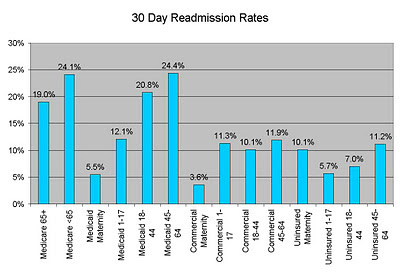Today’s Managing Health Care Costs Indicator is 17.4%
Paul Starr, the sociologist whose “The Social Transformation of American Medicine” helped many of us understand the history behind the financing and delivery of our health care system, has a long thoughtful piece about the “Medicare Bind” in the November American Prospect.
Starr is a liberal, and American Prospect tilts left, but he’s pretty clear that the status quo will be unsustainable over time. He points out that Medicare would be 17.4% of the federal budget in 2020, assuming that there is no fix of the SGR 29.4% physician pay schedule cuts, which is dubious. Medicare will continue to crowd out other programs – so figuring out how to purchase better value with Medicare is key to our future economic well-being.
Starr challenges Democratic orthodoxy, and states that Medicare had a fatal flaw from when it was established.
Ultimately, however, we need to recognize that establishing a separate health-insurance program for seniors was not a good idea in the first place, and the fairest and most effective way to control Medicare’s costs will be to bring health insurance for seniors under the same rules and policies that govern health insurance for everyone else—though, as the varied systems of other countries show, there is more than one way to achieve that goal.
He points out that the initial program paid providers too generously, offered stingy coverage (no drug coverage, no catastrophic coverage, no limits to out of pocket payment) and was dizzyingly complex (four programs, Medicare Part A with the hospital trust fund for inpatient care, Medicare B funded by premiums and tax revenue for outpatient care, Medicaid for the poor and those with disabilities, and private Medigap plans to cover the plethora of holes.)
Medicare has also increased the cost of health care by paying for hospital capital expenses, leading to overbuilding, and by making medical education payments an entitlement, leading to oversupply of some specialties. He says
Most people see Medicare as a program serving the elderly; what they miss is that Medicare has also been a program serving the health-care industry, financing its expansion.
But it’s been hard to reform the system. Starr’s explanation:
Yet by protecting the larger part of the public, concealing the system’s true costs, and enriching the health-care industry, the nation’s policies have made every attempt at reform politically treacherous. The United States
Medicare has created a large bloc of voters who do not realize how great a public subsidy they receive and who think that other people shouldn’t expect government to help pay for their health care.
He points out that there are many elements of potential future cost saving built into the Affordable Care Act, including the the Payment Advisory Board, comparative effectiveness research, bundled payment pilots, accountable care organizations,
Starr on patient cost-sharing:
The evidence is that increased patient cost-sharing does reduce health costs to some extent. But as a general remedy for rising health costs, this approach has much less to recommend it than many people assume. Americans already pay a higher percentage of health-care costs out of pocket than do people in the other rich democracies, yet total costs are much higher in the United States United States
He notes there are a few options to address health care access and cost:
On the right: Moving to vouchers, as proposed by Paul Ryan and passed by the House of Representatives earlier this year. This would be untenable without health care exchanges.
On the left: Single tax supported universal coverage system
The first will lead to much higher patient costs (the CBO suggested the Ryan plan would double the cost of health care for the elderly). The second is politically untenable, and probably not compatible with American culture. Some hybrids could include a public option plan to compete with existing private plans, or allowing 55-65 year-olds to buy into Medicare. He notes that either such a plan would need to be wary of adverse selection.
Starr’s conclusion:
Health policy is not like a mathematical problem that has only one correct solution. The many countries that provide good health care at a reasonable cost do so in a variety of ways that reflect their distinctive institutions and history. The United States
 3:06 AM
3:06 AM
 indigo
indigo







